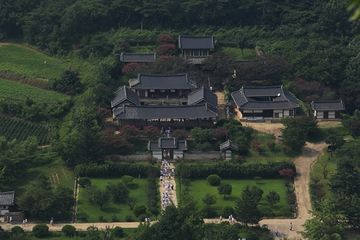안동 병산서원
| 안동 병산서원 Byeongsanseowon Confucian Academy, Andong |
|
 안동 병산서원, 국가문화유산포털, 문화재청. |
|
| 대표명칭 | 안동 병산서원 |
|---|---|
| 영문명칭 | Byeongsanseowon Confucian Academy, Andong |
| 한자 | 安東 屛山書院 |
| 주소 | 경상북도 안동시 풍천면 병산리 30번지 |
| 지정(등록) 종목 | 사적 제260호 |
| 지정(등록)일 | 1978년 3월 31일 |
| 분류 | 유적건조물/교육문화/교육기관/서원 |
| 시대 | 조선시대 |
| 수량/면적 | 27,251㎡ |
| 웹사이트 | 안동 병산서원, 국가문화유산포털, 문화재청. |
|
|
|
해설문
국문
서원은 조선시대에 세워진 사립 교육기관으로, 선현 제향과 교육의 기능을 수행하였다.
병산서원은 조선시대의 재상이자 학자였던 서애 류성룡(西厓 柳成龍, 1542~1607)을 기리고 후학을 양성하기 위해 1614년에 세운 서원이다. 류성룡은 이황(李滉, 1501~1570)의 제자로, 문과에 급제한 뒤 중요한 관직을 두루 거쳤다. 특히 임진왜란 당시 이순신(李舜臣, 1545~1598)을 추천하여 전쟁에 대비한 것으로 유명하다. 전란 중에 영의정에 제수되어 국가의 위기를 극복하는 데 온 힘을 기울였다.
류성룡은 풍산에 있던 풍악서당을 1572년 현재 병산서원의 위치로 옮기고 문중 자손들을 위한 교육시설로 사용하였다. 이후 1614년 제자들과 지역의 유림이 서당에 존덕사(尊德祠)를 세우고 류성룡의 위패를 모시면서 서원으로 재탄생하였으며, 1662년에는 류성룡의 셋째 아들이자 그의 학문을 계승한 류진(柳袗, 1582~1635)을 추가로 제향하였다. 1863년 철종(1849~1863 재위)이 병산서원이라는 이름을 내려주었는데, ‘병산’은 자연경관이 병풍을 둘러치듯 아름답다고 하여 불린 이름이다. 1868년 서원을 모두 철폐하라는 명이 내려졌을 때도 국가의 존중을 받아 철폐되지 않은 47개 서원 가운데 하나였다.
경내에는 입교당을 비롯한 강학영역을 앞에 배치하고 존덕사를 비롯한 제향영역을 뒤에 배치하였다. 이 외에 휴식 공간인 만대루와 문서와 유물을 보관하는 장판각, 제기와 제구를 보관하는 전사청, 서원을 관리하던 노복들의 거처공간인 고직사 등의 건물이 있다. 병산서원은 서원이 번성하던 시기의 한 본보기로 여겨질 만큼 지은 솜씨가 빼어나고 보존이 잘 되어 있으며, 주변의 아름다운 자연과 조화를 이루도록 지은 점에서 ‘한국 서원 건축의 백미’로 이름나 있다.
2019년 7월 “한국의 서원”이라는 이름으로 다른 8곳의 서원과 함께 유네스코 세계문화유산에 등재되었다.
영문
Byeongsanseowon Confucian Academy, Andong
Confucian academies, called seowon in Korean, are private education institutions of the Joseon period (1392-1910) which usually combined the functions of a Confucian shrine and a lecture hall.
Byeongsanseowon was established in 1614 to honor Ryu Seong-ryong (1542-1607), a renowned statesman and eminent Confucian scholar. Ryu was born in Hahoe Village in Andong and became a student of Yi Hwang (1501-1570, pen name: Toegye), one of Korea's greatest Confucian scholars. After passing the state examination in 1566, he served various official posts for about 40 years. In 1590, he was appointed as chief state councilor, the highest governmental position. Fearing the outbreak of a Japanese invasion, he made various preparations including recommending Yi Sun-sin (1545-1598) to the court as a navy commander, which proved crucial when the Japanese did indeed invade in 1592 and Admiral Yi went on to win the war.
In 1572, Ryu had the Pungakseodang Village Study Hall relocated from today's Pungsan-myeon area to this site to educate the descendants of his family. In 1614, after Ryu's death, his students and other local Confucian scholars established a Confucian academy here with a shrine called Jondeoksa to enshrine Ryu's spirit tablet. In 1662, the spirit tablet of Ryu Jin (1582-1635), who was Ryu Seong-yong’s third son and academic successor, was added to the shrine. The name of this Confucian academy was bestowed by King Cheoljong (r. 1849-1863) in 1863 and means "a Confucian academy with a beautiful landscape standing like a folding screen." Although most shrines and Confucian academies were shut down by a nationwide decree in the late 19th century, Byeongsanseowon was allowed to remain open in recognition of its significance among Confucian scholars in the Gyeongsang-do area.
Byeongsanseowon is regarded as the masterpiece of Confucian academy architecture. Its buildings were built with advanced techniques and have remained in good condition. The overall layout of the complex harmonizes well with surrounding natural lansdcape. The complex consists of a lecture hall area at the front and a ritual area at the back. In front of the main lecture hall called Ipgyodang is a large pavilion named Mandaeru, which was also used as a lecture hall and space for leisure. Other auxiliary buildings include a repository for printing woodblocks, a ritual preparation hall, and a living quarters for servants.
Along with eight other Confucian academies, Byeongsanseowon was inscribed on the UNESCO World Heritage List in 2019 under the name "Seowon, Korean Neo-Confucian Academies."